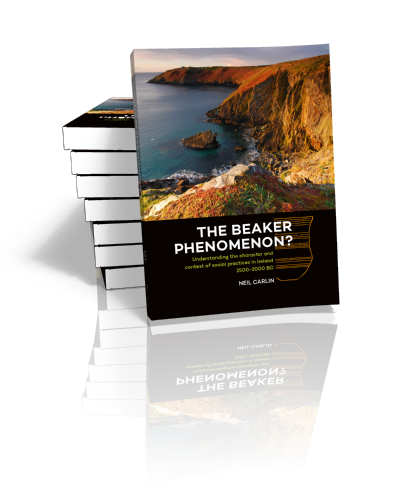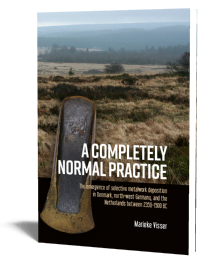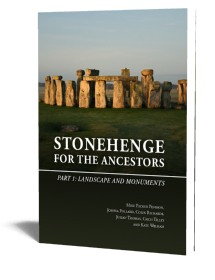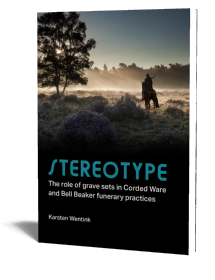The Beaker Phenomenon?
Understanding the character and context of social practices in Ireland 2500-2000 BC
Neil Carlin | 2018

The Beaker Phenomenon?
Understanding the character and context of social practices in Ireland 2500-2000 BC
Neil Carlin | 2018
Paperback ISBN: 9789088904639 | Hardback ISBN: 9789088904646 | Imprint: Sidestone Press Dissertations | Format: 210x280mm | 244 pp. | Language: English | 68 illus. (bw) | 45 illus. (fc) | Keywords: prehistory, archaeology, Beaker Phenomenon, Bell Beaker Culture, depositional treatment, Ireland, Chalcolithic, Early Bronze Age, social practices, identity, adaptation | download cover
Read online or downloaded 2116 times
-
Digital & Online access
This is a full Open Access publication, click below to buy in print, browse, or download for free.
-
Buy via Sidestone (EU & UK)
-
Buy via our Distributors (WORLD)
For non-EU or UK destinations you can buy our books via our international distributors. Although prices may vary this will ensure speedy delivery and reduction in shipping costs or import tax. But you can also order with us directly via the module above.
UK international distributor
USA international distributor
-
Bookinfo
Paperback ISBN: 9789088904639 | Hardback ISBN: 9789088904646 | Imprint: Sidestone Press Dissertations | Format: 210x280mm | 244 pp. | Language: English | 68 illus. (bw) | 45 illus. (fc) | Keywords: prehistory, archaeology, Beaker Phenomenon, Bell Beaker Culture, depositional treatment, Ireland, Chalcolithic, Early Bronze Age, social practices, identity, adaptation | download cover
Read online or downloaded 2116 times

We will plant a tree for each order containing a paperback or hardback book via OneTreePlanted.org.
During the mid-third millennium BC, people across Europe started using an international suite of novel material culture including early metalwork and distinctive ceramics known as Beakers. The nature and social significance of this phenomenon, as well as the reasons for its rapid and widespread transmission have been much debated. The adoption of these new ideas and objects in Ireland, Europe’s westernmost island, provides a highly suitable case study in which to investigate these issues. While many Beaker-related stone and metal artefacts were previously known from Ireland, a decade of intensive developer-led excavations (1997-2007) resulted in an exponential increase in discoveries of Beaker pottery within apparent settlement contexts across the island. This scenario is radically different from Europe where these objects are found with Beakers in funerary settings, stereotypically with single burials.
Using an innovative approach, this book interlinks the study of the pottery and various object types (that have traditionally been studied in isolation) with their context of discovery and depositional treatment to characterise social practices within settlements, funerary monuments, ceremonial settings and natural places. These characterisations deliver rich new understandings of this period which reveal a much more nuanced narrative for this international phenomenon.
Significantly, this integrated regional study reveals that the various Beaker-related objects found in Ireland were all deposited during a series of highly structured and rule-bound activities which were strongly influenced by pre-existing Irish traditions. This is a departure from previous interpretations which incorrectly attributed the adoption of Beakers to large-scale immigration or a prestige goods economy. Instead, these new international ideas, objects and practices played an important role in enabling people in Ireland to perform and negotiate their personal and group identities by using this new suite of object to frame and maintain their social relations with other groups across Europe.
Acknowledgements
Preface
1. Introduction: querying the Beaker Phenomenon?
1.1 Understanding the Beaker complex?
1.2 ‘Similar but different’?
1.3 Local worlds: people, places and things
1.4 Structure, scope and methodology: a road map
2. New versions of old stories
2.1 Introduction
2.2 Beaker ‘culture’ and cultural-historical approaches
2.3 Early 1900s: Beaker-free Ireland says No to Romans
2.4 The 1930s: the first Irish Beaker boom
2.5 The 1940s and 50s: the arrival of Beaker invaders
2.6 The 1960s and 70s: new beginnings
2.7 The 1980s and 1990s: Irish Beaker elites – the ‘Lunula lords’
2.8 The 2000s: Beaker excavation boom – data vs knowledge
2.9 Shifting chronologies: the legacy of Lough Gur and Newgrange
2.10 Fragmentary pasts: non-integrated typologies
2.11 Problematising prestige and recent developments
2.12 Post-colonial Beaker-rich Ireland
3. A settled past
3.1 Beaker pottery in Ireland
3.1.1 The distribution of Beaker pottery
3.1.2 A context for Beakers
3.2 Infamous Beaker ‘settlements’
3.2.1 Lough Gur
3.2.2 Newgrange
3.2.3 Knowth
3.2.4 Monknewtown
3.3 Settling some issues?
3.4 Dwelling on the evidence?
4. Remembering everyday life
4.1 Introduction
4.2 Beaker-associated pits
4.3 Spreads and middens
4.4 Fulachtaí fia
4.5 Connecting spreads and pits
4.6 Ideologically significant depositions
4.7 Beaker settlement in Ireland in its wider context
5. Fragments of the Dead?
5.1 Introduction
5.2 Beaker deposition in wedge tombs
5.3 Beaker deposition in court tombs
5.4 Beaker deposition in passage tombs
5.5 Beaker deposition in portal tombs
5.6 Beaker deposition in cists
5.7 Beaker deposition in ring-ditches and ring-barrows
5.8 Beaker deposition in pit graves
5.9 Understanding deposition in mortuary and megalithic contexts
5.10 Wedge tombs and cists as Beaker burials?
5.11 A wider European context?
6. Commemorations of Ceremonies Past?
6.1 Introduction
6.2 Beaker deposition in timber circles
6.3 Beaker deposition at timber circles
6.4 Beaker deposition in earthen enclosures
6.5 Understanding Beaker ceremonial deposition
7. Transformational acts in transitional spaces
7.1 Introduction
7.2 Beaker-related objects in bogs, rivers and lakes
7.3 Beaker-related objects in dryland ‘natural places’
7.4 Identifying depositional patterns and practices
7.5 Beaker-related objects in ‘natural places’ in Europe?
7.6 Understanding deposition in boglands in Ireland
8. A time for Beakers?
8.1 Introduction
8.2 Methodology and date selection criteria
8.3 The dating of the Irish Beaker phenomenon
8.4 Dating depositional practices
8.5 Comparing Ireland to Britain?
9. Everything in its right place?
9.1 Introduction
9.2 Beaker Pottery
9.3 Polypod bowls
9.4 V-perforated buttons
9.5 Wrist-bracers
9.6 Copper Daggers
9.7 Sun-discs
9.8 Lunulae
9.9 Gold bands and basket-ornaments
9.10 Battle Axes
9.11 Identifying depositional patterns and practices
10. The Beaker phenomenon in Ireland and Beyond?
10.1 The genomic transformation of north-west Europe?
10.2 External influences?
10.3 Continuity and change?
10.4 Beaker pots: commemorating the domestic
10.5 The meanings of Beaker-related objects?
10.6 Personhood and ‘personal possessions’
10.7 Transformation rituals
10.8 Supra-regional cosmologies?
10.9 Rites of passage in sacred places?
10.10 The Beaker transformation?
10.11 The Beaker Phenomenon?
Bibliography

Dr. Neil Carlin
Neil Carlin is a lecturer in the School of Archaeology at University College Dublin. His research concentrates on the Neolithic and Bronze Age of Ireland and Britain in their European contexts. Much of this is focused on how people construct and negotiate their social relationships, identities and worldview through their everyday material engagement with their world, including the routine production, use and disposal of objects in specific places.
Abstract:
During the mid-third millennium BC, people across Europe started using an international suite of novel material culture including early metalwork and distinctive ceramics known as Beakers. The nature and social significance of this phenomenon, as well as the reasons for its rapid and widespread transmission have been much debated. The adoption of these new ideas and objects in Ireland, Europe’s westernmost island, provides a highly suitable case study in which to investigate these issues. While many Beaker-related stone and metal artefacts were previously known from Ireland, a decade of intensive developer-led excavations (1997-2007) resulted in an exponential increase in discoveries of Beaker pottery within apparent settlement contexts across the island. This scenario is radically different from Europe where these objects are found with Beakers in funerary settings, stereotypically with single burials.
Using an innovative approach, this book interlinks the study of the pottery and various object types (that have traditionally been studied in isolation) with their context of discovery and depositional treatment to characterise social practices within settlements, funerary monuments, ceremonial settings and natural places. These characterisations deliver rich new understandings of this period which reveal a much more nuanced narrative for this international phenomenon.
Significantly, this integrated regional study reveals that the various Beaker-related objects found in Ireland were all deposited during a series of highly structured and rule-bound activities which were strongly influenced by pre-existing Irish traditions. This is a departure from previous interpretations which incorrectly attributed the adoption of Beakers to large-scale immigration or a prestige goods economy. Instead, these new international ideas, objects and practices played an important role in enabling people in Ireland to perform and negotiate their personal and group identities by using this new suite of object to frame and maintain their social relations with other groups across Europe.
Contents
Acknowledgements
Preface
1. Introduction: querying the Beaker Phenomenon?
1.1 Understanding the Beaker complex?
1.2 ‘Similar but different’?
1.3 Local worlds: people, places and things
1.4 Structure, scope and methodology: a road map
2. New versions of old stories
2.1 Introduction
2.2 Beaker ‘culture’ and cultural-historical approaches
2.3 Early 1900s: Beaker-free Ireland says No to Romans
2.4 The 1930s: the first Irish Beaker boom
2.5 The 1940s and 50s: the arrival of Beaker invaders
2.6 The 1960s and 70s: new beginnings
2.7 The 1980s and 1990s: Irish Beaker elites – the ‘Lunula lords’
2.8 The 2000s: Beaker excavation boom – data vs knowledge
2.9 Shifting chronologies: the legacy of Lough Gur and Newgrange
2.10 Fragmentary pasts: non-integrated typologies
2.11 Problematising prestige and recent developments
2.12 Post-colonial Beaker-rich Ireland
3. A settled past
3.1 Beaker pottery in Ireland
3.1.1 The distribution of Beaker pottery
3.1.2 A context for Beakers
3.2 Infamous Beaker ‘settlements’
3.2.1 Lough Gur
3.2.2 Newgrange
3.2.3 Knowth
3.2.4 Monknewtown
3.3 Settling some issues?
3.4 Dwelling on the evidence?
4. Remembering everyday life
4.1 Introduction
4.2 Beaker-associated pits
4.3 Spreads and middens
4.4 Fulachtaí fia
4.5 Connecting spreads and pits
4.6 Ideologically significant depositions
4.7 Beaker settlement in Ireland in its wider context
5. Fragments of the Dead?
5.1 Introduction
5.2 Beaker deposition in wedge tombs
5.3 Beaker deposition in court tombs
5.4 Beaker deposition in passage tombs
5.5 Beaker deposition in portal tombs
5.6 Beaker deposition in cists
5.7 Beaker deposition in ring-ditches and ring-barrows
5.8 Beaker deposition in pit graves
5.9 Understanding deposition in mortuary and megalithic contexts
5.10 Wedge tombs and cists as Beaker burials?
5.11 A wider European context?
6. Commemorations of Ceremonies Past?
6.1 Introduction
6.2 Beaker deposition in timber circles
6.3 Beaker deposition at timber circles
6.4 Beaker deposition in earthen enclosures
6.5 Understanding Beaker ceremonial deposition
7. Transformational acts in transitional spaces
7.1 Introduction
7.2 Beaker-related objects in bogs, rivers and lakes
7.3 Beaker-related objects in dryland ‘natural places’
7.4 Identifying depositional patterns and practices
7.5 Beaker-related objects in ‘natural places’ in Europe?
7.6 Understanding deposition in boglands in Ireland
8. A time for Beakers?
8.1 Introduction
8.2 Methodology and date selection criteria
8.3 The dating of the Irish Beaker phenomenon
8.4 Dating depositional practices
8.5 Comparing Ireland to Britain?
9. Everything in its right place?
9.1 Introduction
9.2 Beaker Pottery
9.3 Polypod bowls
9.4 V-perforated buttons
9.5 Wrist-bracers
9.6 Copper Daggers
9.7 Sun-discs
9.8 Lunulae
9.9 Gold bands and basket-ornaments
9.10 Battle Axes
9.11 Identifying depositional patterns and practices
10. The Beaker phenomenon in Ireland and Beyond?
10.1 The genomic transformation of north-west Europe?
10.2 External influences?
10.3 Continuity and change?
10.4 Beaker pots: commemorating the domestic
10.5 The meanings of Beaker-related objects?
10.6 Personhood and ‘personal possessions’
10.7 Transformation rituals
10.8 Supra-regional cosmologies?
10.9 Rites of passage in sacred places?
10.10 The Beaker transformation?
10.11 The Beaker Phenomenon?
Bibliography

Dr. Neil Carlin
Neil Carlin is a lecturer in the School of Archaeology at University College Dublin. His research concentrates on the Neolithic and Bronze Age of Ireland and Britain in their European contexts. Much of this is focused on how people construct and negotiate their social relationships, identities and worldview through their everyday material engagement with their world, including the routine production, use and disposal of objects in specific places.
-
Digital & Online access
This is a full Open Access publication, click below to buy in print, browse, or download for free.
-
Buy via Sidestone (EU & UK)
-
Buy via our Distributors (WORLD)
For non-EU or UK destinations you can buy our books via our international distributors. Although prices may vary this will ensure speedy delivery and reduction in shipping costs or import tax. But you can also order with us directly via the module above.
UK international distributor
USA international distributor
- Browse all books by subject
-
Search all books

We will plant a tree for each order containing a paperback or hardback book via OneTreePlanted.org.
You might also like:
© 2025 Sidestone Press KvK nr. 28114891 Privacy policy Sidestone Newsletter Terms and Conditions (Dutch)








